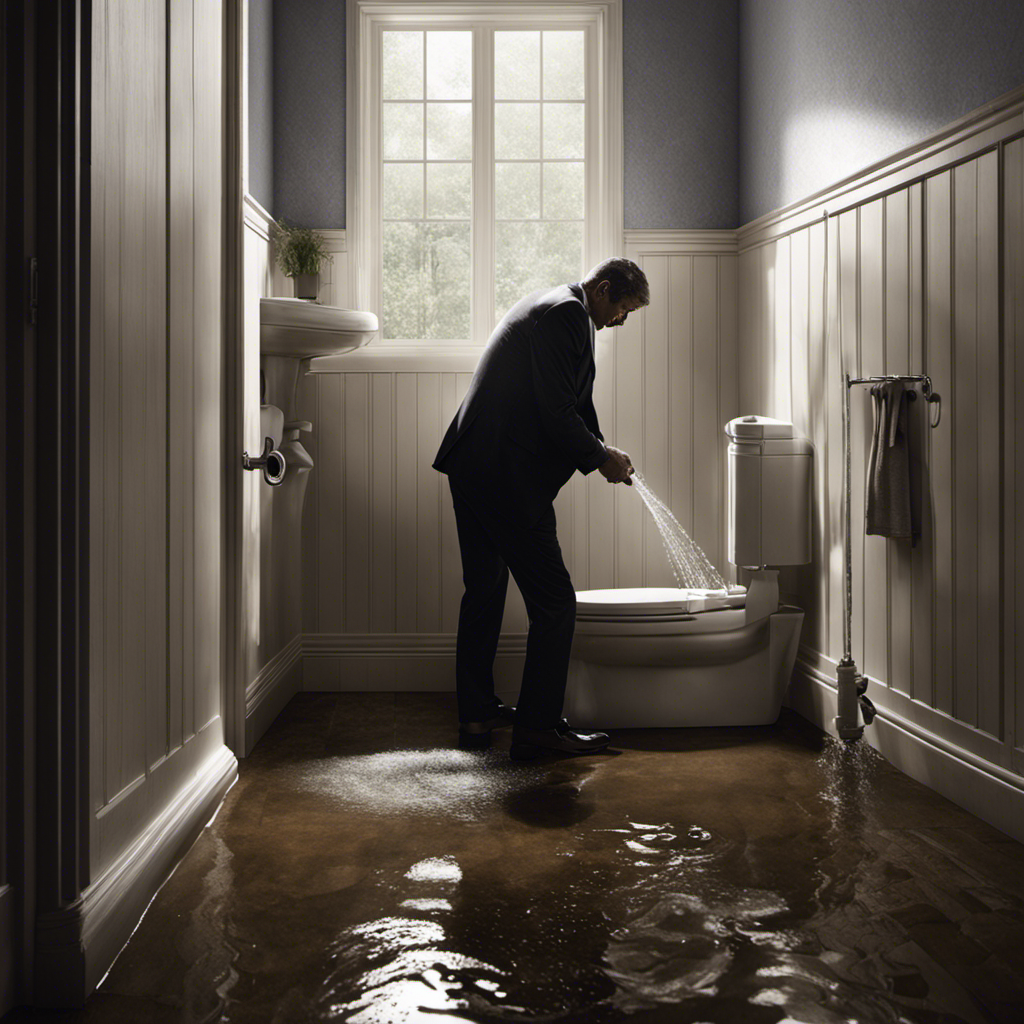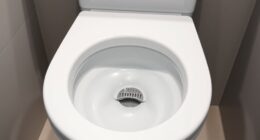As someone who has experienced the frustration of a water outage, I understand the temptation to flush the toilet even when the water is off. However, it’s important to know the potential consequences of such an action.
In this article, we will explore the mechanics of flushing without water, the possible damage it can cause, and tips for preventing issues when the water is turned off.
So before you make a decision that could lead to costly repairs, let’s delve into what happens if you flush the toilet when the water is off.
Key Takeaways
- Flushing without water can cause damage to the plumbing system.
- Alternative water sources can be used for flushing, such as stored water, rainwater, or melted snow.
- Flushing without water can lead to clogging, backflow, and foul odors.
- Proper maintenance, water conservation, and having a supply of water for emergencies are important.
The Potential Consequences of Flushing a Toilet Without Water
If you flush the toilet when the water’s off, it can cause damage to the plumbing system. This is especially important to consider in the context of water conservation.
Traditional flush toilets use a significant amount of water with each flush, which can be wasteful in areas where water scarcity is a concern. To address this issue, there are alternatives to traditional flush toilets that can help conserve water.
These include dual-flush toilets, which offer different flushing options depending on the type of waste, and composting toilets, which break down waste into compost instead of using water for flushing.
Understanding the mechanics of flushing with no water supply is crucial to avoid potential damage to the plumbing system and to explore more sustainable options for water conservation.
Understanding the Mechanics of Flushing With No Water Supply
Without water, you won’t be able to operate the flushing mechanism in your toilet. When the water supply is cut off, your toilet won’t be able to fill up the tank, and as a result, flushing becomes impossible. This can be quite inconvenient and frustrating, especially when you need to use the toilet urgently.
Troubleshooting common toilet flushing problems in such situations involves checking if there is a problem with the water supply or if there is a blockage in the pipes. In cases where the water supply is temporarily unavailable, exploring alternative water sources for flushing toilets might be necessary. This can include using stored water, rainwater, or even melted snow.
However, it is important to note that these alternatives should be used sparingly and responsibly to conserve water.
Possible Damage and Malfunctions Caused by Flushing Without Water
When the water supply is cut off, you’ll face potential damage and malfunctions from flushing your toilet. It is important to understand the possible consequences to avoid costly repairs. Here are some things that can happen when you flush without water:
-
Clogging: Without water, waste may not be properly flushed down the drain, leading to clogs that can be difficult to clear.
-
Backflow: Flushing without water can cause a reverse flow of sewage, resulting in foul odors and contamination of your bathroom.
-
Damaged components: The lack of water can put unnecessary strain on the flushing mechanism, causing parts to break or malfunction.
To prevent these issues, it is crucial to have a well-maintained toilet and be prepared for plumbing emergencies. Regular maintenance and knowing how to shut off water to your toilet can help mitigate the risks associated with flushing when the water is off.
Tips for Preventing Issues When the Water Is Turned off
To prevent potential problems, it’s important to properly maintain your toilet and be prepared for situations where the water supply is turned off. Taking precautions can save you from headaches and costly repairs.
When the water is off, don’t flush the toilet. Flushing without water can cause damage to the plumbing system, leading to leaks and blockages. It’s crucial to conserve water during these times, so refrain from using the toilet unnecessarily.
If you need to use the toilet, pour a bucket of water into the bowl to create enough force for a one-time flush. Remember to keep a supply of water available for emergencies, such as a rainwater harvesting system or stored water containers.
How to Properly Flush a Toilet When the Water Supply Is Restored
Once the water supply is restored, you can simply press the handle to flush the toilet as usual. However, it is important to remember that during water shortages or emergencies, it is crucial to conserve water.
Here are some tips to help you flush the toilet properly and conserve water:
-
Fill a bucket: Instead of using the flush handle, you can fill a bucket with water and pour it into the toilet bowl. This will create enough force to flush the waste away.
-
Use emergency toilet alternatives: In case of a prolonged water outage, it is advisable to have emergency toilet alternatives such as portable camping toilets or composting toilets.
-
Install a dual-flush system: Consider installing a dual-flush system in your toilet. This allows you to choose between a low-flush option for liquid waste and a high-flush option for solid waste, saving water in the process.
Frequently Asked Questions
Can Flushing a Toilet Without Water Cause Any Health Hazards or Contamination?
Flushing a toilet without water can pose potential health risks and lead to contamination. It is crucial to ensure the availability of water before flushing to avoid the spread of bacteria and maintain proper hygiene. Water conservation measures should be followed to minimize such situations.
Is It Possible for a Toilet to Overflow When There Is No Water Supply?
When the water is off, flushing the toilet can cause an overflow if there’s residual water in the tank. This is due to the lack of sufficient water pressure to flush the waste properly. It’s important to maintain proper toilet function to prevent water wastage.
What Are the Potential Long-Term Effects of Repeatedly Flushing a Toilet Without Water?
Repeating toilet flushing without water can have potential consequences. It can damage the plumbing system, cause clogs, and lead to costly repairs. Moreover, it can waste water and have a negative impact on the environment.
Are There Any Alternative Methods to Flush a Toilet When the Water Is Turned Off?
There are alternative flushing methods available when the water is turned off. You can use a bucket of water or a portable water supply to manually flush the toilet.
Can Flushing a Toilet Without Water Lead to Any Damage to the Plumbing System?
Flushing a toilet without water can cause potential damage to the plumbing system. The lack of water can lead to blockages, pipe cracks, and necessary repairs. It’s crucial to avoid flushing when the water is off.
Conclusion
In conclusion, flushing a toilet when the water is off can lead to a range of unpleasant consequences. The lack of water supply can cause damage to the toilet’s flushing mechanism, resulting in malfunctions and costly repairs.
However, by following proper precautions and understanding the mechanics of flushing without water, you can prevent these issues. Remember to never force the flush and wait until the water supply is restored before attempting to flush again.
Stay informed and avoid unnecessary headaches in the future.










